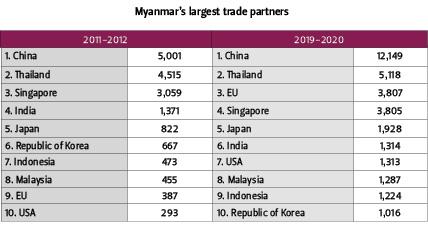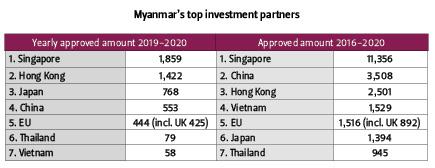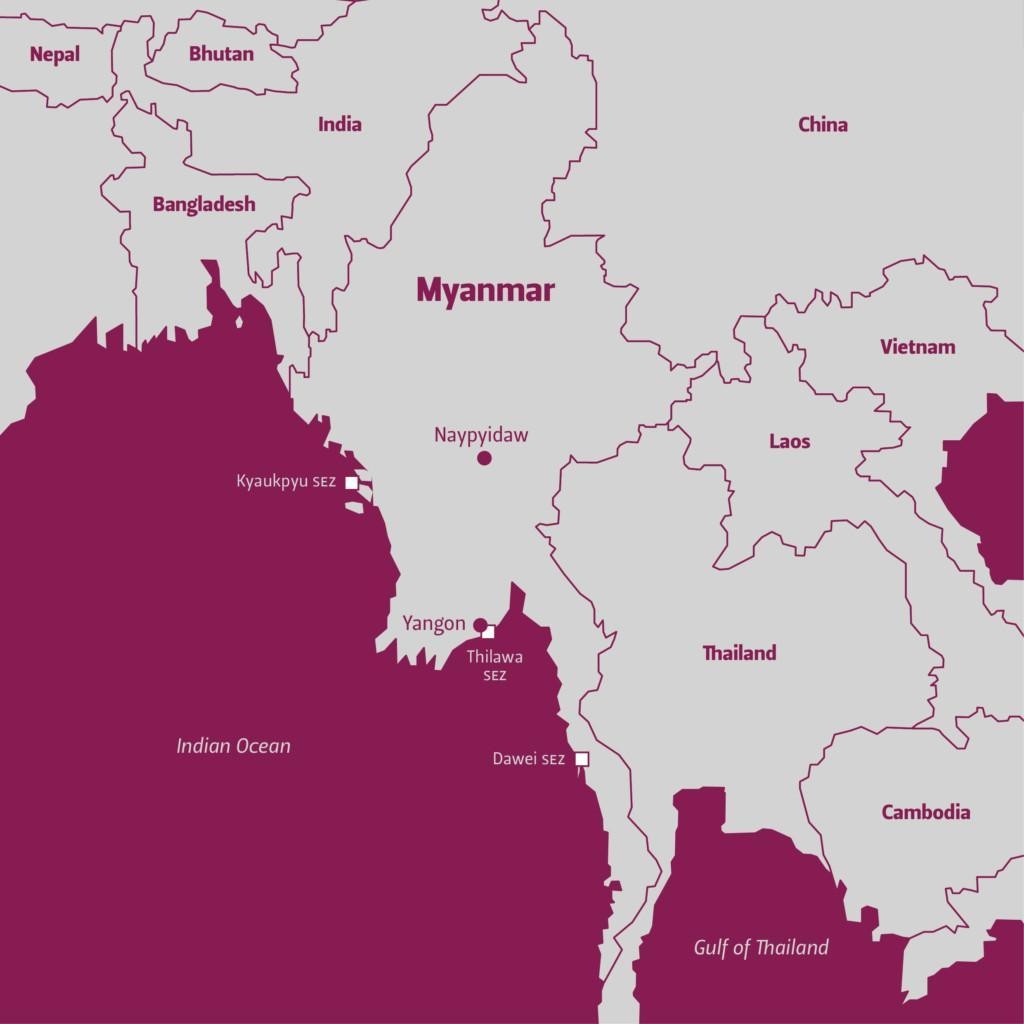yhteenveto
Maat, joilla on geostrategisia intressejä Myanmarissa, ovat reagoineet eri tavoin helmikuun 1. päivän 2021 sotilasvallankaappaukseen ja sen jälkiseurauksiin, jotka ovat aiheuttaneet tähän mennessä yli 750 ihmisen kuoleman.
Kiina hyötyy Myanmarin vakaudesta. Huomattavien geotaloudellisten ja -poliittisten intressiensä vuoksi Kiina ei arvostele maan armeijaa. Thaimaa, itsekin sotilashallinnon alainen pseudodemokratia, on varmasti haluton kohdistamaan painetta Myanmariin. Intia keskittyy omaan kansalliseen etuunsa ja priorisoi kumppanuutta naapurinsa kanssa.
Japani käyttää hiljaista diplomatiaa ja pyrkii toimimaan sovittelijana, mutta samalla se suojelee kaupallisia intressejään. EU ja Yhdysvallat ovat asettaneet pakotteita, mutta historia osoittaa, ettei näillä ole juurikaan vaikutusta sotilasjunttaan. Venäjällä ei ole maassa merkittävää asemaa, mutta maan hallinto käyttää asekauppaa hyväkseen saadakseen jalansijaa Aasian ja Tyynenmeren alueella.
ASEAN pyrkii neuvottelemaan Indonesian johdolla ja jopa saavutti laajan konsensuksen Myanmarin tilanteesta. Järjestö on kuitenkin todennäköisesti liian jakautunut saadakseen aikaan pysyvää muutosta.
Koska ulkoisten toimijoiden geostrategiset intressit Myanmarissa poikkeavat toisistaan, keskitettyä toimintaa muutoksen aikaansaamiseksi ei todennäköisesti ole luvassa. Siksi pysyvän muutoksen on synnyttävä maan sisällä.
Introduction
After staging a coup on 1 February 2021 and declaring a year-long state of emergency, Myanmar’s military (Tatmadaw) installed a military-run State Administration Council (SAC), and promised future elections in order to establish a “genuine and disciplined democratic system” as part of a five-point roadmap. In a speech soon after the coup, Commander-in-Chief Min Aung Hlaing emphasized the leading role of the Tatmadaw in national politics during the past ten-year “multiparty democratic system”, which, in the eyes of the outside world, constituted a promising, decade-long process of cautious democratization. The general also seemed to hint at “business as usual” in the forthcoming foreign as well as trade policy with partner countries, welcoming investments and promising to resume exports.
The coup made it clear that the military has no intention of giving up its constitutionally-embedded position of power in Myanmar’s state structure, and that for them democracy can only be “disciplined”, that is, by giving a key role to the Tatmadaw in the country’s domestic politics, including in the Nationwide Ceasefire Agreement (NCA), but also in its economic policy and foreign relations. But how have partner countries and external actors reacted to the developments in the country formerly known as Burma? Now that over 750 people have died in the ongoing and, for the military, probably much more resilient than expected demonstrations following the coup, is there anything the international community can do to prevent Myanmar from becoming a failed state?
This Briefing Paper explores the geostrategic interests of external actors in Myanmar. It argues that, ideally speaking, concerted efforts by outside actors could have some positive influence on the internal dynamics of Myanmar, but this is unlikely given the divergent interests at stake.
The big picture
First and foremost, a cursory look at trade and investment figures illustrates some of the changes that have taken place in Myanmar during the past decade. Official trade statistics show that China remains by far Myanmar’s most important trade partner, with both import and export more than doubling (Table 1). [1] Trade with the Association of Southeast Asian Nations (ASEAN) partners – Thailand, Singapore, Indonesia and Malaysia – also grew significantly. Trade with the EU grew tenfold after the EU reviewed Myanmar’s exclusion from the Generalized System of Preferences (GSP) in 2012, and suspended all restrictive measures apart from the arms embargo. Trade with the US expanded nearly fivefold, and trade figures with Japan more than doubled.

Table 1. Myanmar’s largest trade partners. The table shows total trade in million USD, figures rounded to nearest million.
Source: Myanmar Trade portal
Myanmar has also become an attractive investment hub, rich in natural resources and with a young labour force. Nevertheless, economic growth has remained low and reforms in sectors such as finance or infrastructure have been slow. Myanmar remains one of the poorest countries in Asia, with approximately 25% of the country’s 54 million people below the poverty line, while the wealth remains concentrated in the hands of a limited group of military leaders and their business cronies.
Singapore is the largest investor in Myanmar and, taken as a whole, ASEAN countries far exceed China’s investments (Table 2).[2] Chinese investments in Myanmar peaked in 2010–2011, amounting to USD 8.3 billion.[3] This figure dropped markedly to 4.3 billion after Myanmar’s new President Thein Sein decided to suspend the 3.5 billion Chinese-funded Myitsone Dam project in late September 2011 in response to wide public protests against its environmental impact and the displacement of over 10,000 people. After dropping further in the following years, investments from China started increasing again after the launch of the Belt and Road Initiative (BRI) in 2014, amounting to 3.3 billion. Official figures currently stand at USD 553 million.[4] The EU is a sizable investor in Myanmar, with the caveat that a large part of these investments derive from pre-Brexit UK.

Table 2. Myanmar’s top investment partners. The table shows investments in million USD, figures rounded to nearest million.
Source: Myanmar Directorate of Investment and Company Administration (DICA)
In general, it can duly be said that external powers have benefitted economically during the era of Myanmar’s cautious democratization. However, Myanmar’s geopolitical position is as important as its attractiveness as a trade and investment partner, and the country can be seen as a battleground for influence by foreign powers. The following sections illustrate further the interests and geostrategic aims of the major players in Myanmar.
China: Big Brother and all-weather friend?
As Myanmar’s largest trade partner by far, and one of its largest investors, China plays a crucial role in the country. One of China’s prime aims has always been to gain access to the Indian Ocean, allowing for oil and gas imports from the Bay of Bengal, thereby bypassing the Strait of Malacca and also giving Beijing greater strategic presence in the Indian Ocean. As one part of the BRI, China has therefore vigorously promoted the China-Myanmar Economic Corridor (CMEC).
A key pillar in the project is Kyaukpyu, in Rakhine State on Myanmar’s Indian Ocean coast. China has constructed oil and gas pipelines from Kyaukpyu to Yunnan in China. In January 2020, the National League for Democracy (NLD) government under Aung San Suu Kyi agreed with China on the development of the Kyaukpyu Special Economic Zone (SEZ). Furthermore, plans are underway to construct a deep-water port, 70% owned by China, in Kyaukpyu, which would give Beijing vital access to the Indian Ocean. The NLD government cemented stronger economic and investment relations with China in 2020, signing 33 agreements with Myanmar on investment and trade.
In addition to investments in the Burmese infrastructure development, China provides BRI loans that come at a high interest rate, resulting in Myanmar owing China USD 4 billion out of a total 10 billion national debt and raising fears of a debt trap. [5] In return for its presence in Myanmar, Beijing has always offered diplomatic support to Myanmar, for example in Myanmar’s handling of the Rohingya crisis. China blocked UN Security Council Resolutions in 2007 and 2008 that demanded an end to human rights violations, and did the same in February 2021 when it vetoed a UNSC statement condemning the coup. Given that Myanmar is key for Beijing’s BRI, it is clear that domestic stability is all that China desires, no matter who is in charge.
This is not to say that the country sometimes referred to in political rhetoric as “pauk-phaw”, meaning “brother”, is warmly welcomed in Myanmar. The uneven division of profits from Chinese infrastructure projects, a looming debt trap, a growing Chinese presence in society, environmental damage and the displacement of local populations as an outcome of China-funded projects have often resulted in feelings of distrust and lingering negative images of China. The months following the coup were marked by anti-Chinese demonstrations, including attacks on Chinese factories. Even so, in view of Myanmar’s importance to China’s BRI, Beijing is expected to continue to cosy up to the generals and remain Naypyidaw’s all-weather friend, something which the junta, ahead of staging the coup, was likely very much aware of.

Thailand: A model for Myanmar’s generals to mimic?
While Thai and Burmese generals enjoy good relations and the Thais could in principle act as a bridge to the outside world, the latter lack credible political clout in terms of promoting democracy in Myanmar. After all, Thailand’s current government came to power in a coup in 2014 and Thailand continues to suffer from a serious democracy deficit itself. Burmese generals have no doubt followed the developments in Thailand closely in the past decades. The Thai military has managed to build a political system that has been referred to as a military-dominated pseudo-democracy. [6]
The Thai model allows for a strong central government dominated by the military that “guides” democracy by suppressing opposition voices with lèse-majesté charges and a constitution that allows the military to have a decisive say in Thailand’s Senate, Election Commission and Constitutional Court. Hence, it is no surprise that the Tatmadaw has reached out to Thailand’s Prime Minister Prayuth Chan-ocha, himself a general, asking for help on Myanmar’s ‘democratic process’. Thailand’s militarily “guided” democracy chimes well with the Burmese version of “disciplined” democracy. In both Thailand and Myanmar, the military wield significant economic and social power, and in both countries, the civil-military relations have been fraught with tension. The result has often been a coup by the military leaders, who have been unhappy with civilian governments seeking more control over the military.
There are a number of ethnic armed organizations in Myanmar that operate along the 2,400 km-long Thai-Myanmar border. Conflict in Myanmar has often spilled over to Thailand in the form of refugees. Thailand is already a haven for over 90,000 refugees that have resided in the rudimentary camps in the border region for decades. According to recent news reports, the Thai army has been preparing temporary shelters to house refugees that have started arriving in some of the border provinces. The refugees will, however, be sent back after the situation returns to ‘normal’.
Thailand has important economic interests in Myanmar: millions of migrant workers from Myanmar have contributed to developing the Thai economy, and Thailand imports most of its gas from Myanmar. While the Thai government has not been too concerned about the coup affecting the Thai economy, some companies are wary of the image and impact of possible international sanctions. In the fiscal year 2018–2019, Thai foreign direct investment in Myanmar was in the region of USD 221 million, dropping to 79 million the following year. [7] The two countries have been interested in the development of the Dawei Special Economic Zone (DSEZ). It was envisaged that the DSEZ would enhance connectivity and supply chains along the Eastern Economic Corridor (EEC) of Thailand and the Southern Economic Corridor (SEC). Furthermore, mobility throughout Thailand and Myanmar would facilitate the flow of trade with a wider reach towards India and Vietnam. All of this is now in peril.
India: National interests trump everything else
India has a 1,643 km-long land border with Myanmar and the countries have an agreement on the free movement of people. India’s three Northeastern states bordering Myanmar, namely Nagaland, Manipur and Mizoram, suffer from internal conflicts. India has been engaging the Tatmadaw regarding insurgency issues in Northeast India as India has needed the Myanmar military’s support to fight anti-India insurgents, whose bases have been located in Myanmar’s jungles. Hence, India has adopted a cautious approach to the events unfolding in Myanmar. While it has expressed support for the democratic transition in Myanmar, it has avoided criticizing the military. India’s position within a recent UN Security Council meeting was that India condemns violence, but urges engagement with the junta. More specifically, India was against sanctions, just like China and Russia. A number of people from Myanmar, including police officers who have defected, have sought refuge in Mizoram. While India has not yet deported them, New Delhi has signalled that Myanmar nationals fleeing into India are not welcome.
India has also invested over USD 2 billion in different development projects in Myanmar, and Indian companies are involved in such infrastructure projects as the Kaladan Multi-Modal Transit Transport Project and the India-Myanmar-Thailand Trilateral Highway. These two projects are part of India’s “Look East – Act East” policy in which India is forging partnerships with third countries in Southeast Asia and beyond. [8] Myanmar’s instability poses obstacles for the implementation of this policy, but it is clear that India needs Myanmar’s cooperation for its “Act East” policy to succeed.
Japan: The quiet mediator
Similarly to China, Japan has strong vested interests in Myanmar. Tokyo is investing heavily in connectivity and development projects in Myanmar, often through Official Development Assistance (ODA) loans (most recently at 0.01% interest rate) financed by the Japan International Cooperation Agency (JICA) and the Asian Development bank (ADB). Myanmar is also a key player in Japan’s connectivity projects under the umbrella of its Free and Open Indo-Pacific (FOIP) policy, aiming to counterbalance China’s BRI.
Since 2015, Japan has invested heavily in the Thilawa SEZ, key in the East-West Economic Corridor. The Japan-led SEZ makes wide use of JICA’s Private-Sector Investment Finance tool, which provides loan aid to private corporations engaging in infrastructure development. The nearby Thilawa Port is vital as a gateway to the Indian Ocean for Japanese manufacturing companies. Japan also aims to invest in the Dawei SEZ, including a deep-sea port vital for the development of the Mekong Southern Economic Corridor (SEC), another key element in Japan’s FOIP policy. Both projects aim to improve connectivity over land from the Indian to the Pacific Ocean, linking Myanmar, Thailand, Laos, Cambodia and Vietnam.
In addition to the return on investments, geostrategic competition with China is one key factor for Japan’s engagement in Myanmar. Both factors are also the reason why Japan has been relatively quiet in voicing criticism of Myanmar’s military. Tokyo has halted new ODA projects, but has not imposed sanctions and has refrained from labelling the events in Myanmar a coup, aiming to keep the door open for silent diplomacy. The Japanese foreign ministry has been very active behind the scenes, including through consultations with ASEAN, the EU and the US, and through its Special Envoy Yôhei Sasakawa, who has been involved in the peace process in ethnic minorities’ areas and reportedly enjoys some leverage over Commander-in-Chief Min Aung Hlaing. Even though Japan emphasizes shared values with the West in its FOIP strategy, its competition with China will entice it to continue to resort to quiet diplomacy as a mediator, while protecting its business and investment interests in Myanmar.
EU and US: Do sanctions matter at all?
In February the EU announced targeted sanctions against the military behind the coup and their economic interests, issuing travel bans and asset freezes, in addition to maintaining the arms embargo. The EU, as well as the US, issued sanctions against Myanma Economic Holdings Limited (MEHL) and Myanmar Economic Corporation (MEC), two important conglomerates controlled by the military. However, similar to the EU’s sanctions policy during the two decades preceding 2011, the state-run Myanmar Oil and Gas Enterprise (MOGE), a key source of income for the military, has not been targeted, allegedly for humanitarian reasons, namely because electricity shortages may hit the local population. MOGE is a partner in the development of the Yadana gas field, operated by the French company Total and including the US-based company Chevron.
Based on history, limited and targeted sanctions are likely to have little effect in reversing the coup, as long as other external actors do not follow suit. Even so, they send an important signal, stigmatizing Myanmar, reducing the country’s international legitimacy, and symbolizing support for political prisoners and pro-democracy groups. [9] Furthermore, they are an integral part of the EU’s so-called comprehensive policy approach, which includes restrictive measures but also political dialogue with all key stakeholders. In addition to targeted sanctions and continued humanitarian assistance, there is little more that the EU and the US can do than support and encourage regional mediation efforts by ASEAN or Japan.
Russia: If Moscow can be part of the problem, why be part of the solution?
Russia is not a significant player in Southeast Asia. However, like despots elsewhere, Burmese generals have been able to count on Russia’s steadfast support. According to SIPRI, Russia’s arms sales to Myanmar amounted to 16 per cent of the country’s total arms imports in the period 2015–2019. Burmese officers have also received training in Russia. Moscow has also supported China in UN Security Council deliberations and together the two have blocked any potential UN sanctions on the Burmese junta. Little wonder that Min Aung Hlaing profusely thanked Russia for its unwavering support for Myanmar on the recent Armed Forces Day by bestowing the visiting Russian deputy Defence Minister with medals and a sword. Incidentally, Russia was the only country to partake at a ministerial level in the Tatmadaw’s outlandish celebrations on the very date that the army murdered over 100 anti-coup protesters.
ASEAN: A divided “diplomatic superpower” stepping up to the challenge?
ASEAN has traditionally adhered to the “ASEAN Way”, placing strong emphasis on national sovereignty and the commitment to non-intervention in the affairs of member countries. At the same time, it has sought political engagement while avoiding isolating and embarrassing its member state governments. [10] Even so, ASEAN has achieved some results through quiet diplomacy.
In the past, ASEAN’s “flexible engagement” of Myanmar in regional affairs can be said to have yielded more results in promoting a peaceful transition towards a more democratic regime than the Western sanctions-based approach. ASEAN admitted Myanmar to the bloc in 1997 and this contributed to the subsequent opening of the country. This time around, however, ASEAN is facing an entirely new situation in which a member is heading towards state collapse. This in turn has major political, security and humanitarian consequences for the bloc. Indonesia has been the most active ASEAN member in the current crisis. President Joko Widodo called for an end to the bloodshed in Myanmar, and was backed up by Malaysia. There has been a flurry of diplomatic activity behind the scenes by some ASEAN diplomats, and statements by ASEAN on the situation in Myanmar have been issued.
Most recently, on 24 April 2021, however, Indonesia succeeded in convening a special ASEAN meeting on Myanmar, inviting Myanmar General Min Aung Hlaing. Although neither Thailand nor the Philippines were represented at the summit at the highest level, the Chairman’s statement agreed on a five-point consensus, calling for a cessation of violence, constructive dialogue, ASEAN mediation including on-the-ground meetings with all parties concerned, and humanitarian assistance. [11] Even though the statement failed to include a reference to the need to free political prisoners, achieving consensus should be seen as a remarkable achievement, in view of the fact that ASEAN managed to come together as an association that includes members such as Thailand, Vietnam, Cambodia and the Philippines, not exactly beacons of democracy themselves. Yet it remains to be seen how the junta will take heed of ASEAN’s stance.
Conclusion: Change can only come from within
Ideally, if outside actors could show true political will, concerted efforts could have some positive influence on the internal dynamics of Myanmar. After all, in general, all external powers have benefitted economically from Myanmar’s “democratic interlude”, and therefore share an interest in trying to ensure stability in the country. However, such a collective external effort is unlikely given the divergent interests. All of the neighbours, particularly Thailand, India and China, have significant economic and political interests at stake. Although they do not wish to see Myanmar plunging into prolonged political turmoil, these countries are reluctant to exert concerted pressure on the junta to backtrack in its power grab.
Politically speaking, the junta’s long-term vision for Myanmar would appear to follow Thailand’s path as a military-dominated pseudo-democracy, albeit in a much cruder form. The EU and US have sanctions as part of their toolbox, but history proves that they do not have much effect on the junta. Russia, a well-known spoiler in the global arena, uses arms sales to establish a foothold in the Indo-Pacific. Japan is resorting to quiet diplomacy in order to function as mediator, while at the same time protecting its business and investment interests in Myanmar. ASEAN is trying to step up to the challenge with Indonesia’s lead, but it remains too divided to be able to deliver sustained change on the ground.
At the end of the day, real and sustained change comes from within societies. Above all, this requires the political will to reform by those in power. Civil society and political opposition can challenge the status quo and gradually force shifts in the power balance. This, in most cases, however, amounts to a long and drawn-out struggle. It appears that Myanmar is heading, once again, for prolonged and protracted conflict.
Endnotes
[1] Official figures from Myanmar Trade portal, https://myanmartradeportal.gov.mm/en/trade-data-charts. For indicative purposes only, as these official figures obviously do not cover the vast amounts of illicit cross-border flows of contraband goods, timber, wildlife, alcohol, tobacco and gems, totalling over USD 6 billion a year. It is estimated that up to 80% of Myanmar’s jade, an industry worth between USD 12 and 31 billion every year, is smuggled out. UNCTAD, “Myanmar steps up fight against illicit trade”, 7 February 2020, https://unctad.org/news/myanmar-steps-fight-against-illicit-trade.
[2] Official figures from the Myanmar Directorate of Investment and Company Administration (DICA). DICA (2021, February). “Foreign Direct Investment Yearly Approved Amount by Country”, https://www.dica.gov.mm/sites/default/files/document-files/yearly_approved_amount_by_country_2.pdf; DICA (2021, February). “Foreign Investment of Permitted Enterprises from FY2016-2017 to 2021 (January) (by Country/Region)”, https://www.dica.gov.mm/sites/default/files/document-files/by_country_6.pdf.
[3] DICA (2018, October). “Foreign Direct Investment Yearly Approved Amount by Country”, https://www.dica.gov.mm/sites/default/files/document-files/bycountry_fil_yearly_0.pdf.
[4] These figures likely do not include investment capital brought in by Chinese mega projects. Cf. https://www.irrawaddy.com/specials/infographic-30-years-chinese-investment-myanmar.html.
[5] Chaudhury, Dipanjan Roy. “Myanmar’s Auditor General cautions own govt against Chinese loans”. Economic Times, 13 June 2020, https://economictimes.indiatimes.com/news/international/business/myanmars-auditor-general-cautions-own-govt-against-chinese-loans/articleshow/76346777.cms.
[6] Chambers, P. (2021). “Commentary: Thailand as a model? Why Myanmar may follow Prayuth’s example”. Channel News Asia, 7 April. https://www.channelnewsasia.com/news/commentary/myanmar-coup-thailand-prawit-military-political-system-lessons-14560352.
[7] DICA (2021, February). “Foreign Direct Investment Yearly Approved Amount by Country”. https://www.dica.gov.mm/sites/default/files/document-files/yearly_approved_amount_by_country_2.pdf.
[8] Gaens, B. and O. Ruohomäki (2018). “India’s ‘Look East’ – ‘Act East’ Policy: Hedging as a Foreign Policy Tool”. FIIA Briefing Paper 222.
[9] Cf. Gaens, B. (2021). “Myanmar’s generals recoup – The recurrence of military-defined ‘disciplined democracy’”. FIIA Comment 3.
[10] Gaens, B. and O. Ruohomäki (2018). “Regionalism à la ASEAN: Past achievements and current challenges”. FIIA Briefing Paper 237.
[11] ASEAN Secretariat (2021). “Chairman’s Statement on the ASEAN Leaders’ Meeting”. Jakarta, 24 April. http://www.asean2021.bn/Theme/news/news-24.04.21-csalm.aspx.


